Austest Adelaide gains full accreditation for Defence and Commercial EMC and Environmental Test Standards
Austest Laboratories recent move to much larger premises at 13 Newfield Road, Para Hills West has facilitated a recent audit, which has resulted in NATA MRA partner accreditation to a vast range of commercial and defence based environmental and EMC standards. This includes vibration and shock, ingress for dust and water, salt spray/corrosion, temperature/humidity testing and Solar + UV.
Austest Adelaide now provides the following scope of accredited testing:
Military EMC
- MIL-STD-461/462B (up to 18 GHz and 50 V/m): CE01, CE03, CS01, CS06, RE01, RE02, RS01, RS02, RS03;
- MIL-STD-461/462C: CE01, CE03, CS01, CS06, RE01, RE02, RS01, RS02, RS03
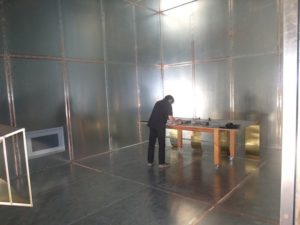
Shielded chamber, Para Hills West SA - MIL-STD-461E / F (up to 18 GHz and 50 V/m): CE101, CE102, CE106, CS101, CS106, CS114, CS115, CS116, RE101, RE102, RS101, RS103
Commercial EMC – Radiated Emissions (10m OATS)
- AS/NZS CISPR 14.1; CISPR 14-1; EN 55014-1;
- AS/NZS CISPR 15; CISPR 15; EN 55015;
- AS/NZS CISPR 32; CISPR 32; EN
Commercial EMC – Conducted Emissions
- AS/NZS CISPR 14.1; CISPR 14-1; EN 55014-1;
- AS/NZS CISPR 15; CISPR 15; EN 55015;
- AS/NZS CISPR 32; CISPR 32; EN 55032;
Environmental – Climatic*

- IEC/EN 50155:2007: – test 12.2.3 Cooling, – test 12.2.4 Dry Heat, – test 12.2.5 Damp Heat, Cyclic, – test 12.2.12 Watertightness, – test 12.2.13 Equipment Stress Screening, – test 12.2.14 Low Temperature Storage;
- MIL-STD-810D, E, F, G, and G With Change 1: – method 501.6 High Temperature, – method 502.6 Low Temperature, – method 507.6 Humidity, – method 504.2 Contamination by Fluids, – method 521.4 Icing/Freezing Rain, – method 524.1 Freeze / Thaw
- MIL-STD-202G: – method 103B Humidity Steady State, – method 106G, Moisture Resistance;
- IEC/EN 60068-2-2;
- IEC/EN 60068-2-30;
- IEC/EN 60068-2-14;
- IEC/EN 60068-2-1;
- IEC/EN 60068-2-78;
- IEC/EN 60068-2-38
- IEC/EN 60068-2-39
- IEC/EN 60068-2-66;
- IEC/EN 60068-2-67;
- DEF STAN 00-035:2006, 2017: – test CL1 Constant High Temperature – Low Humidity, – test CL2 High Temperature and Low Humidity, – test CL4 Constant Low Temperature, – test CL5 Low Temperature, – test CL6 High Humidity and High Temperature, – test CL7 Constant High Temperature – High Humidity, – test CL10 Icing, – test CL17 Elevated Ground-Temperature/Humidity Diurnal Cycles, – test CL24 Freeze-Thaw, – test CN4 Contamination by Fluids,
- DEF(AUST)5681:1998 – Section 7.2 Climatic Tests
- RTCA DO160G – Section 4 Temperature and Altitude; – Section 6 Humidity, – Section 5, Temperature Variation, – Section 11 Fluids Susceptibility

Altitude test – Aircraft Display Unit - ISTA 3A-test blocks 1, 2;
- ISTA 2A-test blocks 1, 2;
- ISTA 2B – test blocks 1,2
- EN 50125-3:2003, – section 4.3 Temperature, – section 4.4 Humidity, – section 4.8 Ice
- AS/NZS 1158.6 (Luminaires) – Clause 5.9 Thermal Endurance and Thermal Testing;
- ISO/AS 7240 – climatic tests covered in parts 2 through to 28 including: – dry heat, – cold, – damp heat cyclic, – damp heat, steady state;
- GMW14650 cl. 4.2;
- GMW14650 cl. 4.3;
- GMW14650 cl. 4.5;
- ISO 16750-4;
- SAE-J1455: – clause 4.1, Temperature, – clause 4.2, Humidity;
- AREMA C&S Manual 2009 Part 11.5.1- section D.1, – section D.2, – section D.3;
- ASTM F2825;
- AS3789:2014 – clause 5.7, – clause 5.8, – clause 5.14;
- AS4607:1999 – clause 3.4
- ST/AG/AC.10/11/Rev. 6:2015 – clause 38.3.4.2 Test T.2 Thermal test
- BS/EN 45502-1:2015 – clause 26.2
- ASTM D4332
Environmental – Mechanical*
- Vibration, Variable Frequency: 1 Hz to 3 kHz; Max Force 10 kN; Max. Velocity 1.8 mm/s; Max. Acceleration 100 g; Max. Displacement 50 mm
- Shock: Max. force: 20 kN, Acceleration Measurements up to ± 2300g at 1 – 12 kHz
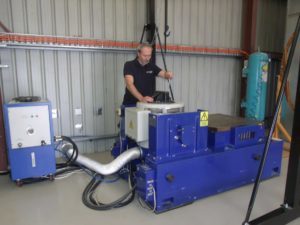
- IEC/EN/AS 60068-2-6;
- IEC/EN/AS 60068-2-27;
- IEC/EN/AS 60068-2-64;
- MIL-STD-810D, E, F, G, and G With Change 1: – method 514.6 Vibration, – method 516.6 Shock, – method 513.6 Acceleration, – method 519 Gunfire Shock;
- MIL-STD-167-1A: – type 1, Environmental;
- MIL-STD-167-1 (ships): – type 1, Environmental;
- MIL-STD-202G: – method 201A Vibration, – method 204D Vibration, High Frequency, – method 213B Shock, – method 214A Random Vibration, – method 207B High Impact Shock
- ISTA 3A-test blocks 3, 4, 6-9;
- ISTA 2A-test blocks 4-6;
- ISTA 1A
- ISTA 2B – test blocks 3, 4, 5, 6, 7
- ASTM D4169-09, -14, -16;
- ASTM D4728
- ASTM D999
- ASTM D6179
- ASTM D880 Test Method for Impact Testing for Shipping Containers and Systems
- ASTM D4003 Test Methods for Programmable Horizontal Impact Test for Shipping Containers and Systems
- IEC 60255-21-1;
- IEC 60255-21-2;
- IEC 60255-21-3;
- ISO 16750-3:2012;
- DEF STAN 00-035:2006, 2017: – test M1 Basic Vibration, – test M2 Complete Store Vibration, – test M3 General Purpose Shock Test, – test M6 Operational Shock Simulation, – test M7 Shock Testing for Warship Equipment and Armament stores, – test M11 Wheeled Vehicle Transportation Bounce, – test M12 Bump
- DEF(AUST)5681:1998 – Section 7.3 Transportation Environment Test
- RTCA DO160G – Section 7 Shocks and Crash Safety; – Section 8 Vibration;
- IEC/EN 61373:2010;
- IEC/EN 50155:2007 – test 12.2.11 Vibration, Shock, and Bump;
- AS/NZS 3439.5;
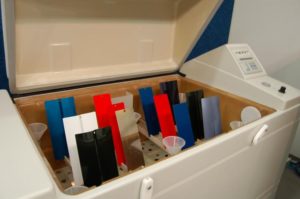
Salt-fog testing (photo courtesy of Q-Lab) - IEC/EN 60068-2-75;
- IEC 62262;
- ISO/AS 7240 mechanical tests covered in parts 2 through to 28 including: – Shock, – Vibration;
- GMW14650 cl. 4.9;
- GMW3172 cl. 9.3.2; GMW3172 cl. 9.3.3;
- SAE-J1455: – clause 4.9, Vibration, – clause 4.4, Shock;
- ANSI C136.31-2010;
- AREMA C&S Manual 2009 Part 11.5.1- sections D.4 & D.5;
- IEC 60068-2-7;
- IEC 60068-2-31;
- IEC 60068-2-55;
- IEC 60068-2-81;
- IEC 61243-2: – clauses 5.4.4, 5.4.5, 5.4.6, 5.4.7, & 5.4.8;
- IATA PI968;
- EN 50125-3:2003 – section 4.13 Vibration and shocks
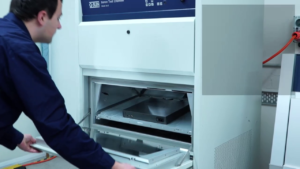
UV broad Spectrum Testing - AS3789:2014 – clause 5.12, – clause 5.13, – clause 5.11
- ST/AG/AC.10/11/Rev. 6:2015 – clause 38.3.4.3 Test T.3 Vibration, – clause 38.3.4.4 Test T.4 Shock
- BS/EN 45502-1:2015 – clause 23.2, Vibration, – clause 23.7, Shock
Environmental – Harsh Atmospheres*
- AS/NZS/IEC/EN 60068.2.52 Salt Mist Test;
- ASTM B117 Salt Spray;
- AS/NZS/IEC/EN 60529
- RTCA DO160G – Section 14 Salt Spray
- IEC 60068-2-11;
- IEC/EN 50155:2007:
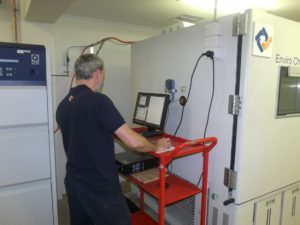
- – test 12.2.10 Salt Mist Test;
- MIL-STD-810D, E, F, G, and G With Change 1: – method 506.6 Rain, Procedure III, – method 509.6, Salt Fog, – method 512.6 Immersion;
- DEF STAN 00-035:2006, 2017: – test CN2 Salt (corrosive) Atmosphere,- test CL29 Immersion,- test CL25 Dust and Sand, Turbulent Dust,- test CL28 Water Drip
- DEF(AUST)5681:1998,- Section 7.5 Ingress Tests, cl. 7.5.1, 7.5.2, 7.5.3, 7.5.4 – Section 7.6 Chemical/Corrosion Tests
- ISO 20653;
- SAE-J1455:- clause 4.3, Salt Spray – clause 4.4, Immersion;
- IEC 60068-2-18
- EN 50125-3:2003 – section 4.6 Rain
- MIL-STD-202G: – method 101E Salt Atmosphere (corrosion) – method 104A Immersion
- ASTM D951
Environmental – UV & Solar Radiation*
- MIL-STD-810D, E, F, G, and G With Change 1: – method 505.6, Solar Radiation (Sunshine) Procedure I and Procedure II;
- IEC 60068-2-5, Edition 2.0 2010-04;
- ISO 4892-2:2006(E);
- ISO 11341:2004;
- ISO 105-B02-2014(E);
- ISO 105-B04-1994;
- ASTM D4459-12;
- ASTM D1248-12;
- ASTM D2565-99 (2008);
- ASTM D4434 / D4434M-11;
- ASTM D4798 / D4798M-11;
- ASTM D4799 / D4799M -08 (2013) e1;
- ASTM D6695-08;
- ASTM C1257-06a (2012);
- ASTM C1442-14;
- ASTM C1501-14;
- ASTM C1519-10;
- ASTM C732-06 (2012);
- ASTM C734-06 (2012);
- ASTM C793-05 (2010);
- ASTM D1148-13;
- ASTM D3424-11;
- ASTM D3451-06 (2012);
- ASTM D4329-13;
- ASTM D4587-11;
- ASTM D4674-02a (2010);
- ASTM D5208-14;
- ASTM D5894-10;
- ASTM D6577-06 (2011) e1;
- ASTM D750-12;
- ASTM D904-99 (2013);
- ASTM D925-14;
- ASTM F1945-05 (2011);
- ASTM G151-10;
- ASTM G154-12a;
- ASTM G155-13;
- DEF STAN 00-035, Part 3, Issue 4 -CL-2, -CL-3, -CL-6;
- ISO 4892-3;
- ISO 15003, Section 5.11
- EN 50125-3:2003 – section 4.9 Solar Radiation
- ASTM G53
*Also using customer supplied test methods directly related to the tests and parameters listed.
A full listing of our SA accredited standards can be found from page 26 onwards, here.
Contact Austest Labs for a quote or to visit our facilities.
